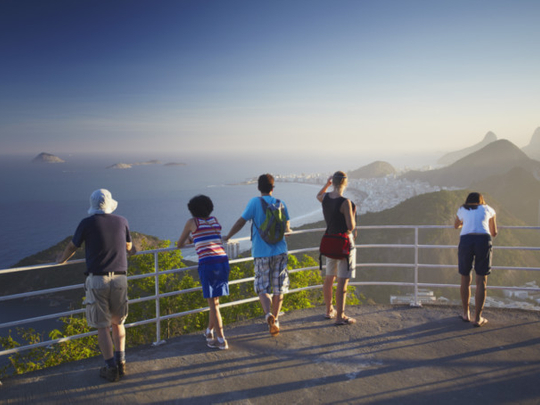
1. Dance in the city of samba
You can’t go wrong with this. Gaze at the iconic Sugarloaf from Copacabana Beach while savouring an acai berry smoothie. After drinking in enough sunshine — yes, even in winter — visit the famed statue of Christ the Redeemer on Corcovado Mountain. The view of the city from here is magical, especially if you can pull off a sunset.
Rio de Janeiro is famous for its funk but how can you leave without some samba? Lapa is home to some of the city’s best samba halls, while Leblon will also keep you well entertained.
2. Discover forro
Brazilians have a reputation for being rhythmically gifted and dance is very important to them. In Fortaleza, it’s all about forro, an art comprising various dance styles and different musical beats. While the city has several venues boasting great night outs, check out Pirata Bar, Mucuripe Club and Obrita Bar.
A rich cultural exchange is on offer at its numerous forro hotspots. For a traditional experience, try Kukukaya. It also has great dishes and regional foods to explore.
3. Spot coral, dodge the sharks
Recife is well known for its abundant coral reefs. In fact, its coast is so embellished with these beauties that the city’s name is derived from them. While Recife boasts wonderful beaches, such as Boa Viagem and Porto de Galinhas, it has a very generous amount of sharks too.
Why not explore Ground Zero? It’s a nice square where Recife was founded and is short distance from the main port. It brings together a diverse group of revellers. Visit the historical sites of Olinda and enjoy a catamaran trip to see why Recife is known as the Venice of Brazil.
4. Kick it with cowboys
Porto Alegre, which literally means Happy Port, is famous for its unforgettable sunset. Gaucho, or cowboy, refers to the people from this cheerful city and they certainly take pride in their traditions.
Gauchos are always welcoming visitors to their cowboy capital, so why not take in the sunset with one while indulging in chimarrao, a herb-infused hot beverage sipped from a calabash. Where else can you drink tea with a cowboy?
5. Learn capoeira in the land of happiness
Salvador, Brazil’s first capital, is a rich source of folklore. It has artistically retained its strong African and European roots, resulting in a graven Brazilian city. Colourful and vibrant, it is known as the land of happiness. Considering its cultural richness, it should be of no surprise that Salvador gave birth to capoeira, samba de roda, and afoxe — an Afro-Brazilian instrument responsible for having influenced many acclaimed Carvaval groups. Let Salvador’s beautiful beaches be the playground for your seaside capoeira lessons. Then top it off with a visit to some of the city’s musical virtuosos — a night out in Pelourinho, a Unesco World Heritage site, will do the trick.
While exploring this colonial area’s history, beauty, bustling nightlife and famous baroque architecture, be sure to sample acaraje, a regional culinary delight comprising a stuffed black-eyed pea fritter topped with shrimps.
6. Try a rumble in the jungle
Manaus is a somewhat shy and small city, gently punctuated by pretty buildings such as the Teatro Amazonas, Sao Sebastiao Church and Museu Numismatica Bernado Campos.
But Manaus is the heart of the Amazonas — do you really want to leave with timid tales to tell? With numerous tourist services, you can easily catch a ferry over into the rain forest. See the meeting of the waters of the rivers Negro and Solomoes, which form a dual-coloured groovy pattern as their densities repel each other, before hacking your way to camp. Fishing for piranhas (what delicious soup it makes!), stalking alligators and swimming with pink river dolphins, you’ll undoubtedly have the experience of a lifetime. From truly rugged survival trails (think of you with a machete, my friend) to the more tame side of the jungle, local guides will tailor packages to suit everyone.
7. Befriend an unforgettable butterfly
Brasilia is unusual, to say the least. This surreal capital city was designed in the form of a butterfly, although many may argue it’s an aeroplane. And yes, it was designed — no organic growth here. It was an intrepid experiment in city development. The result, officially inaugurated in 1960, is the modernist landscape by the hand of Brazil’s notorious architect, Oscar Niemeyer.
Famous for its futuristic buildings, Brasilia is home to the National Congress, the Cathedral and the Presidential Palace. Be sure to include the Legion of Goodwill Temple, a seven-storey heptagonal pyramid impressively adorned with the world’s largest crystal, in your sightseeing itinerary.
8. Experience the cultural party
Sao Paulo is, without a doubt, the pounding heartbeat of Brazil. Affectionately dubbed Sampa, it is home to more than 11 million fun-loving people. Where should you start? Avenida Paulista is a good idea. Visit Sao Paulo’s Museum of Art before relaxing in Choperia Opcao, a cafe just around the corner.
Sampa is home to the biggest Japanese community outside of Japan, so sushi is abundantly available, but locals also love pastel — freshly fried filled pastries. Try the state’s fine-quality meat, rodizio-style (eat until you pop), as well as the pizza. Visit the Mercado Municipal, a market with fresh produce, tasty fare and various crafts. Kick back at Parque Ibirapuera.
9. Go green cosmopolitan-style
Curitiba, with its urban planning and environmentally friendly policies that go back to the 1970s, is a green city. The landscape is generously peppered with parks and woods, many of which sport names that pay homage to the city’s multicultural heritage.
Bosque Alemao, or German Woods, boasts the Philosophers’ Tower, which offers a beautiful panorama of Curitiba. Parque Tingui, named after the region’s indigenous people, has a Ukrainian memorial, while Parque de Portugal reflects the Portuguese heritage.
Visit Bosque Joao Paulo II and discover Polish wooden houses. Top off your dose of all things green with a trip to the Curitiba Botanical Garden and the Botanical Museum.












